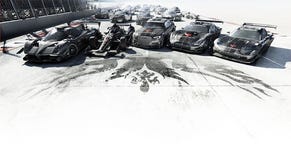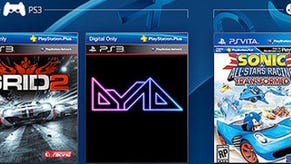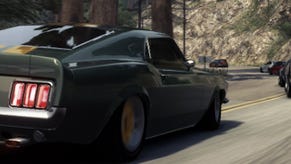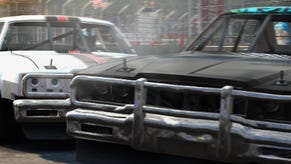GRID 2 interview: total race immersion returns
GRID 2 has taken a long time to surface, but it's finally here and looking good. VG247's Dave Cook speaks with developer Codemasters to learn more about career mode, multiplayer and the studio's approach to racing purity.
"The ‘race’ is at the very heart of what we are doing with GRID 2, with every aspect overhauled and notched up to new levels. Early on in pre-production we talked a lot about 'Total Race Day Immersion,' and this has been the guiding design philosophy across every aspect of the game."
Over the last four years Codemaster has successfully launched two DIRT games, two F1 titles and more, yet GRID 2 was just revealed recently. Many gamers have been asking why it's taken the studio so long to return to the series.
VG247 caught up with GRID 2 executive producer Clive Moody, lead programmer Gary Buckley, and associate producers Toby Evan-Jones and Iain Smith to find out how the studio has used the past four years to make GRID 2 a worthy sequel.
VG247: Why has GRID 2 taken so long to surface?
Clive Moody: That’s probably the question I’ve been asked more than any during the last couple of years. There’s been a very conscious effort to take our time over creating GRID 2, more than anything because of the ambition we have for the game.
The original GRID launched relatively early in the current generation console lifecycle, meaning that although our racing engine technology was in a really good place, we knew there was a lot more to come.
Getting to a state where every element of the technology supports our ambition has taken considerable time and investment. It’s great to now be able to break cover and show everyone just how far the GRID experience has progressed during that time.
Two race locations have been revealed so far. Can you talk us through your approach to the geography in GRID 2?
Clive Moody: GRID 2 stages the player in three continents of racing; US, Europe and Asia, each featuring an array of exciting and diverse race events. Creating accurate representations of each location and really capturing the unique look, feel and tone of each location is hugely important and an area of the game in which we invest heavily.
Our level designers and artists research the locations thoroughly, taking tens of thousands of photographic images and hours of video capture, which enables us to create highly accurate in-game representations.
What is key however, is ensuring that this level of accuracy does not get in the way of great gameplay. The careful selection of routes coupled with smart use of barriers enables us to shape corners and manage road widths.
The end result is perfectly paced and flowing circuits, balancing out-and-out foot to the floor straights, dramatic high speed turns and challenging corner sequences for the player to chain together.
We saw a few of those locations in the GRID 2 reveal trailer, and what looked like multiple race disciplines. How many disciplines are you looking at for the final release?
Toby Evan-Jones: The supercharged atmosphere of street racing was certainly one of the core elements of the original GRID, so it’s no surprise that street racing is making a whole-hearted return for GRID 2. Think Supercars tearing up some of the most iconic cities from around the globe.
In addition to this there are a number of other key race disciplines that deserve to be featured. At one end of the spectrum we have Track Racing, taking place on a mixture of classic and modern motorsport circuits, such as Abu Dhabi’s Yas Marina.
At the other end of the spectrum, and a far cry from packed circuit grandstands, we have Road Racing, taking place in locations that are far more remote. These locations offer a real challenge for drivers to take on the twists and turns of nature, such as the forested patches and sheer drops of California’s coastline.
The original GRID disciplines had a unique race mechanic in that they were a halfway house between arcade and simulation handling. Will gameplay follow the same format in GRID 2?
Toby Evan-Jones: This is an incredibly important area for us. The original GRID was “all about the race” and this is a mantra which is absolutely driving the sequel.
Putting everything else aside for a moment, the single most important area within GRID 2 is the player’s experience when on-track, driving some of the most iconic, aspirational vehicles that the world has to offer.
Delivering a handling model to the player which feels authentic, exciting, occasionally scary and massively rewarding has been the goal. To enable us to deliver this the TrueFeel handling model has been developed, which breaks the model down to three core values.
Firstly the key character of each individual vehicle must be captured and portrayed to the player. We’ve hand-picked a selection of the world’s most exciting vehicles, so it’s incredibly important that we let the player understand how these cars truly feel to drive.
Secondly, vehicle setup is fine-tuned in order to ensure accessibility, allowing novice racers to get the car around the track whilst maintaining a real depth and longevity for the experienced player.
Lastly, the previous two stages - raw authentic handling and accessibility tuning - should be met without the use of any assists. Assists have the effect of numbing the driving experience and having the game apply braking forces, manage throttle input and help with steering all prevent a player from learning the true characteristics of a vehicle.
On top of those core mechanics players will be able to use the Flashback rewind time feature again. Why is this important to your racing titles?
Toby Evan-Jones: Flashback was a genuine innovation to the racing genre, which having been introduced in GRID has found a place in many of our racing titles and been mimicked by other developers.
The challenge for us was how we could re-invent flashback to tie more closely into the raw on-track experience, keeping the player immersed in the drama of the race whilst still offering that second chance. We’ll be talking more about what we have in store for Flashback soon.
GRID was a huge game, and I know a few people who never made it to the end because other games came along and such. How long do you hope the career mode of GRID 2 to be?
Iain Smith: We are aware of that, and that’s why it’s not being dealt with as a “how long?” question. The single player journey needs to have the perfect number of highs and lows, tension and reward and well timed points of player progression.
So the question for us was not so much about making the game longer or shorter, but more to do with guiding and encouraging the player through the GRID 2 experience, so that they are rewarded by seeing as much of the game as possible. It’s about what’s right for GRID 2 and your journey as a racing driver.
We’re also being very clear about the multiplayer and single player experiences being separate unique parts of the game. So gamers will be able to take that multiplayer journey as far as they want it to go in isolation from their single player progression.
How are you looking to sustain interest in the campaign this time around – be it through a greater variety of modes, a bigger range of locations and so on?
Iain Smith: You’re right, content such as the cars and tracks play an important role here. The GRID 2 career mode will almost be broken down into sections or chapters, where the player will be visiting different regions and proving their skills, before taking on the competition at a more global scale further into the game.
That means that the player can branch out and visit new locations and take on the next level of competition in faster vehicles. The unique things we’re doing to illustrate the player’s journey are actually what I’m most excited to spill the beans on, but we’re revealing more detail on this a little further down the line.
In the interim, some things I can tell you about are how the player’s surroundings actually evolve around you. As you attend events and begin to beat other drivers, your garage will evolve to include more technical kit and goodies to support you on your rise to the top of the motorsports world.
That notion is also supported by the evolution of the tracks themselves. The crowds become bigger and more passionate as the events become more prestigious.
The dressing of the race tracks becomes more professional and corporate, with bigger sponsors and more elaborate trackside decoration. All of this culminates to make a more believable, rewarding journey for the player. But as I say, this is just the start of that.
Moving away from the campaign and core modes, GRID also had its share of skill games incorporating drifting and other tricks, and in DIRT 3 you had Gymkhana. What are your plans for skill rounds in GRID 2?
Toby Evan-Jones: Variety is key here. Some old classics are returning along with a host of new experiences that are already keeping the team here playing late into the evenings.
Earlier you touched briefly on multiplayer. What plans have you got in store for RaceNet this time around?
Iain Smith: RaceNet is a fundamental part of the push and pull of the online area of GRID 2. It is a constant in this respect. So rather than adding an umbrella service that feels dislocated from the rest of the title, we’re creating modes which rely on the connected nature of RaceNet.
The intention is really to offer unique experiences in this part of the game, which are only actually possible when you’re connected to thousands of other players, rather than just doing the standard race modes but with online players in place of our AI.
RaceNet is important to us for two main reasons. We obviously want to provide these unique experiences for players and create different ways to play that will captivate players online.
Secondly, we actually like the idea that the online space is a two-way method for content delivery. It makes it easier for us now to see what works and what doesn’t and actually for players to influence the direction of the content.
The online realm is a living and breathing space where our players and how they play changes all the time, so why shouldn’t we change and adapt too? Through the RaceNet portal, we’re able to keep things fresh on a real-time basis and constantly update the content itself and the challenges, goals and aims of the player.
Are you able to tell us about the full mutliplayer modes you're considering for GRID 2, or other social features?
Iain Smith: Multiplayer in detail will be unveiled further down the line, but suffice to say we’re putting a lot of emphasis on its design right now. By breaking the game into single player and online, we’re making a statement about the emphasis we’re giving the multiplayer experience.
Where the goals of the single player game are ultimately finite, what we’re intending with the multiplayer aspect is an online journey that players can take as far as they want, and in ways that they want to.
This includes strategic choice of when and how they may want to upgrade their vehicles, to how they make a statement about their online identity and personalise their cars.
Across everything we've touched on so far, what key values did you absolutely have to bring back and improve upon from the original GRID in GRID 2? Racing fans can be purists after all.
Clive Moody: GRID 2 established itself as a landmark racer with its core focus being ‘all about the race’. Of late within the genre, it feels like there have been many games with an emphasis on driving or chasing, but very few that focus on racing, and none in my opinion that capture the speed, thrill and emotional highs and lows of the original GRID.
The ‘race’ is at the very heart of what we are doing with GRID 2, with every aspect overhauled and notched up to new levels. Early on in pre-production we talked a lot about “Total Race Day Immersion” and this has been the guiding design philosophy across every aspect of the game; technical, gameplay, visuals and audio.
We really want the player to feel the tension, the rush of adrenaline, experience heart-stopping wow moments and above all feel like a superstar racing driver.
And how far are you squeezing power out of PS3 and Xbox 360 respectively? Are you – like many other studios – now yearning for the next generation of hardware to come along and offer you more clout?
Gary Buckley: The engine has been developed across several titles now but we're constantly looking to push the limits and find new ways to get more from the hardware, GRID 2's lighting improvements for example. The challenge for the team is to raise the bar with whatever hardware we're working on.
How could next-gen hardware impact on Codemasters' racing titles, and racing games in general going forward?
Gary Buckley: The PC version of our engine has high-end options that push today's best PC's and is regularly used by benchmarking sites to stress test new kit. We work closely with the hardware vendors to try to get as much as we can from their cards and it's a good idea of what the engine can do given the right hardware.
Free-to-play is a big talking point going into the next-gen of console hardware. You have F1 Online on your slate now. How far are we from seeing a DIRT or GRID online? Would you entertain a game like that?
Clive Moody: F1 Online demonstrates brilliantly how our games can be expanded to new audiences on different formats. I don’t see GRID or DiRT being any different in that respect, but to take things a stage further, I love the idea these games should be both complimentary and connected to the console experience.
There’s no good reason why lapsed console gamers or those with restricted time shouldn’t be able to enjoy, contribute and compete in the worlds that we create and there are a wealth of opportunities to deliver this, via RaceNet on all types of connected device.
GRID 2 will launch on PC, PS3 and Xbox 360 across Europe summer 2013.











